A look at Windows 8 Tablets running on TI, Qualcomm, Nvidia, AMD and Intel silicon
by Brian Klug on September 14, 2011 9:00 PM ESTThis afternoon (and yesterday) we had a chance to meet with a number of SoC vendors who have partnered with Microsoft for Windows 8. Each of them has their own individual reference tablet running Windows 8, and today we had a chance to survey the landscape and get photos of all the tablets. We started with ARM, then looked at x86 based tablets. Of course, the real goal with Windows 8 is to abstract as much of the difference between these two platforms away.
Unfortunately, all of the ARM vendors were required to keep their tablets under glass and out of the way of physical contact per Microsoft instruction. Microsoft isn't ready to show off the ARM version of Windows 8 for a variety of reasons at this point (at least without a Microsoft rep. present), but we still got a chance to at least take a look at what there is now. Microsoft is encouraging tablet makers to target either a 10.1" or 11.6" form factor with 1366x768 resolution (ed: Metro will require 1024x768 as a minimum, so 1280x720 displays don't meet Microsoft's requirements).
Texas Instruments
First up is TI, whose development platform was demoed playing back the 1080p30 H.264 baseline video shown in the keynote fluidly in windows media player with a split-screen view. One tablet displayed the start menu, another displayed two split screen games. TI's development platform as shown right now is running on OMAP 4430, which again consists of two ARM Cortex A9s at 1.0 GHz and PowerVR SGX 540 graphics. Windows 8 won't launch on OMAP 4430, however, instead it'll launch on the more powerful OMAP 4470 platform with PowerVR SGX544 graphics and a 2D display compositor. The reason is partly due to SGX544 having full Direct3D 9.3 compliance, partly because it's an all around faster platform. I'm told that right now there's some Direct3D emulation going on as well for all the SoCs that don't support Direct3D 9.3.
I also recorded a short video showing the TI Windows 8 tablet in action.
Qualcomm
My next stop was Qualcomm, whose current development tablet runs on an MSM8660 SoC, which consists of two scorpion cores and Adreno 220 graphics. Qualcomm took the tablet out of the glass box for us and showed a quick demonstration of the start menu scrolling back and forth, and the IE10 mobile view working and scrolling around.
Unfortunately we weren't allowed to shoot video of the tablet while that demo was running, but we did grab some photos of the tablet without the glass box. Performance on the start menu looked to be above 30fps the whole time but not buttery smooth like the x86 tablets we've seen so far.
Just like TI, Qualcomm won't go to market with the SoC they're demonstrating Windows 8 working on today, instead they'll use the more powerful dual core Krait MSM8960 at first and quad core Krait APQ8064 later on. Dual core krait SoCs (eg 8960, 8270, 8260A) come with Adreno 225, quad core krait (APQ8064 and others) come with Adreno 320, both of which are Direct3D 9.3.
NVIDIA
We've seen NVIDIA's Kal-El quad-core A9 based tablet a few times now, and found it out on the floor, also behind glass. Unlike the other vendors, NVIDIA hasn't said anything about going to market for Windows 8 with anything but Kal-El, and I don't see any reason why they should either.
The Kal-El development tablet was seated in a nice looking dock with what looks like one USB 3.0 port and a full size HDMI port.
AMD
Switching over to the x86 camp, we have AMD, who showed us two tablets running on Brazos - the Acer Iconia Tab W500 and MSI WindPad 110W, which use a C-50 and Z-01 APU, respectively. Displays on these are 1280x800 and support capacitive touch just like you'd expect for Windows 8.
Both the MSI WindPad and Iconia Tab felt snappy and responsive running the same Windows 8 Developer Preview build that we've used on the Samsung developer hardware. Subjectively, the WindPad's capacitive panel was more responsive and less prone to errant touch recognition than the Iconia, though both were more than useable with Windows 8.
Intel
Last but not least is Intel's own development tablet, which is running an unnamed 32nm SoC. Intel was suspiciously silent about which particular SoC was inside this device, and you'll notice that it too is locked down in a plastic box, lumping it squarely in the next-gen SoC category for Microsoft.
It's possible this is Medfield, it's also possible this is some 2nd gen 32nm Atom SoC. Hopefully we'll find out more as Windows 8 starts getting closer to launch.


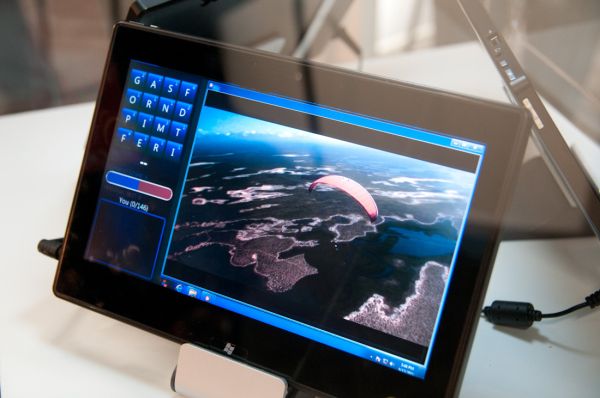
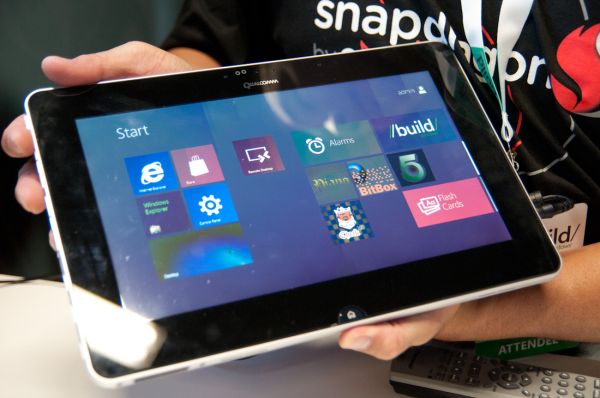
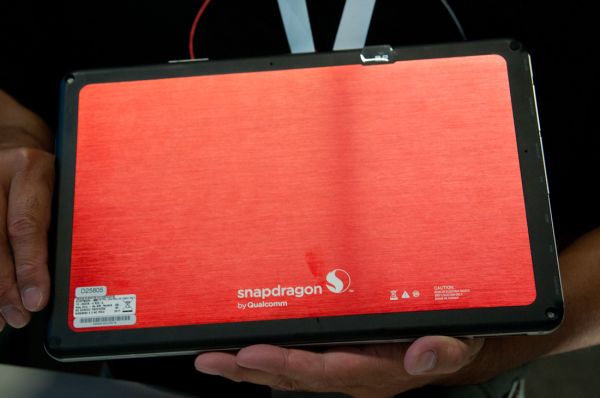
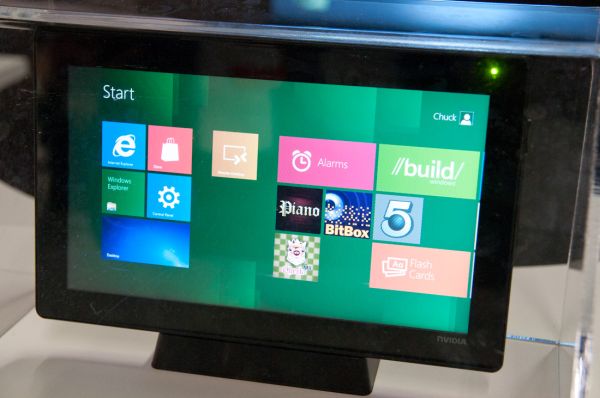
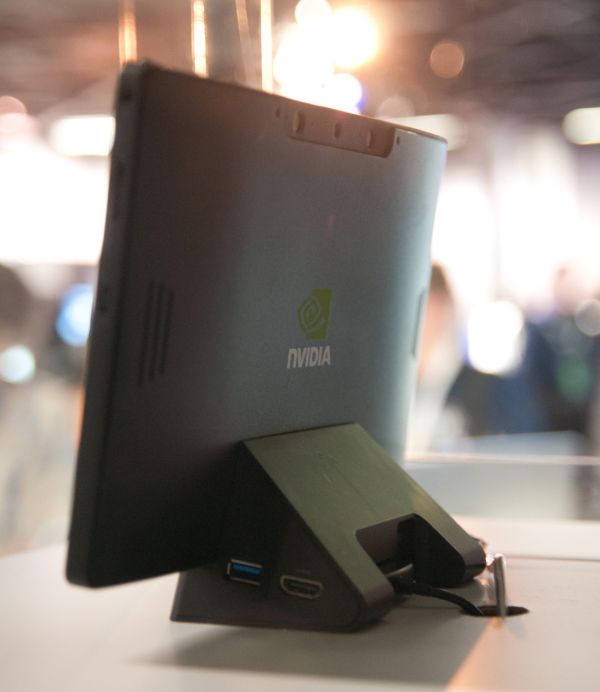
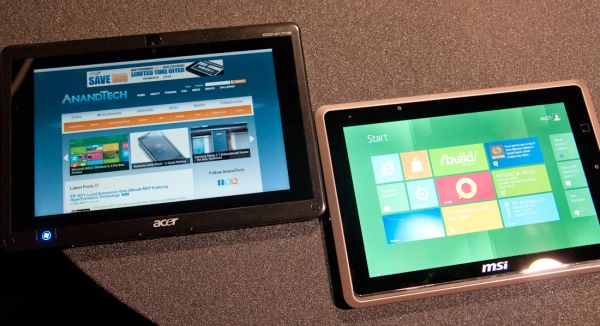
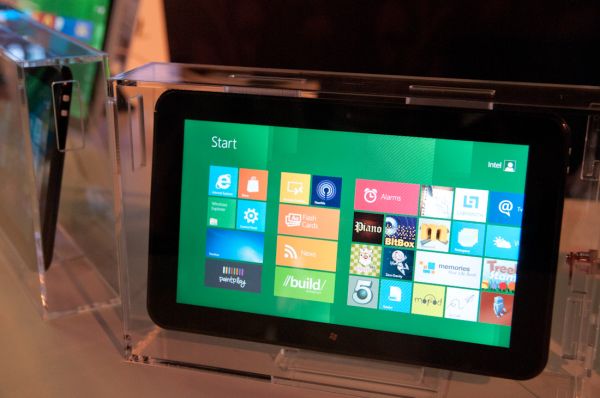














92 Comments
View All Comments
ssj4Gogeta - Wednesday, September 14, 2011 - link
Hopefully, with Windows 8's launch, we'll start seeing more "open" tablet platforms, just like the desktop is today. You buy the hardware, and decide what software to run on it, what bootloader to use, etc. without having to resort to hacking.Samus - Wednesday, September 14, 2011 - link
Ok...but why would you want to run anything but Windows 8? It's cross platform and Metro interface already put it ahead of any linux distribution (excluding Android, if you want to consider that a linux distro)Basically with Apple being proprietary, Palm currently in limbo, Symbian/Meego practically dead, and Microsofts announcement of no tablet plans for WinMo, you have two options in the tablet-world: Windows 8 and Android.
Windows 8 has numerous advantages over Android, but Android does have the Android Market with a ton of apps. It really depends on if you want to do real stuff on your tablet, or just want a toy running Android.
Windows 8 will allow you to run Windows PROGRAMS, which are far more useful than Android Apps. Quickbooks, custom SQL databases, 3DStudioMax, Adobe CS, the list goes on why Windows has already won the profitable business-platform.
People will remember back to iOS and Android tablets, those short-lived devices that pioneered the mass-consumer market adoption, but just couldn't do anything but play games, surf the web and check email.
Unless everything goes cloud-based (which it never will, an 'offline' mode will always be neccessary) then Windows wins by default by simply having programs such as those listed above.
Bob-o - Wednesday, September 14, 2011 - link
> Ok...but why would you want to run anything but Windows 8? It's cross> platform and Metro interface already put it ahead of any linux distribution
> (excluding Android, if you want to consider that a linux distro)
Gosh, I can't imagine why. . . oh wait, got it - because things change? Because people keep developing new versions of software? Because my needs are not your needs? Try not to be so narrow-minded.
Xorg is improving support for touchscreen input. Various linux distros are working on new UI shells and toolkits to accommodate tablets. Who knows what next year may bring. Or the next.
LauRoman - Wednesday, September 14, 2011 - link
Because Win8 does not support all ARMs and i'm not only talking here about single core 600mhz A8s but about higher freq ones too.Belard - Thursday, September 15, 2011 - link
Doesn't matter... Win8 will run on current and future ARM CPUs.Remember, Metro software runs on it's own API and it requires all apps to run on ARM. With that, WinMobile8 will come out for phones and tablets and guess what happens? Instant powerful apps for tablets.
It's brilliant.
(typed on my iPad)
Lucian Armasu - Thursday, September 15, 2011 - link
How exactly? You do realize you won't have those "powerful apps" on Windows for ARM, right? And if they can be made for Windows for ARM later on - why couldn't they be made for iOS or Android, too?You keep talking about "powerful apps" on "Windows tablets". Well even on a 2h battery life Intel chip that supports all those apps, the experience will be extremely poor just as it has always been on Windows tablets, because those apps are not optimized for touch.
Lord Moldy butt - Thursday, September 15, 2011 - link
Ever heard of Moorestown? x86 SoC designed by intel for smartphones and tablets. Since I havent read up too much on Windows 8 on tablets I'll reserve judgement on MS not allowing normal programs to run on the tabletversion, but bear in mind there are alternatives to the
ARM question.
blackrifle - Thursday, September 15, 2011 - link
Do you actually believe the crap you type? 2h battery life Intel chip? Extremely poor experience? You think developers won't go back and modify legacy programs to provide touch support on W8? Yeah, nothing ever gets updated.You need to take it easy on the meth, buddy.
Rick83 - Friday, September 16, 2011 - link
Most of the applications for Windows are written in one of the followig:Java
C/C++
.NET
I'd expect that compiling the latter two for Windows/ARM is going to be relatively easy once Visual Studio with platform support is out.
So stuff that is icc compiled, or features hand-optimized assembler will be harder to port, but that should be a minority. Also anything needing a certain hardware graphics support may not run on lesser devices - but that's nothing new.
So yes, software would have to be re-released for Windows/ARM or Windows/Multi , but if the Windows API is the same for ARM and x86, which should be the case, then there's really nothing to do in porting for 99% of the software than a quick recompile.
Performance will be another issue.
Lord Moldy butt - Thursday, September 15, 2011 - link
Linux isnt an option IMO, it is still way too far behind the power curve compared to Windows or OSX for that matter. I do understand thatlinux is improving, but improving touchscreen input is a lousy kind of
rebuttal, and with so many distro's out there it lacks coherence in any
way. If the driver issue (which isnt really linux fault) was better handled
by companies that design PC components, it would more than likely be
more widely adopted as a primary OS.